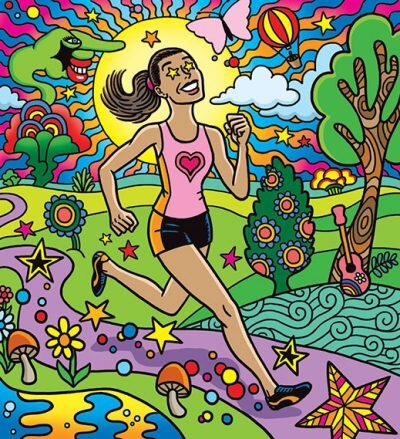Sometimes it happens after a few miles, sometimes after a lot of miles and sometimes never. It’s that feeling of elation, euphoria, and happiness runners chase called the “runner’s high.” Yet, it’s elusive, as timing and effort is different for everyone, and it happens more frequently in some people than in others.

Illustration by Ward Sutton
Specifically, it’s that moment during a run when pain and discomfort fades, as every step begins to feel comforting, effortless and peaceful. There’s an overwhelming sense of strength, power and accomplishment that makes you feel like you can keep running forever, along with a sense of focus, where you feel like you’re in control, but time stands still.
What causes it?
The exact reason is still unknown. Scientists are still trying to figure out what causes a runner’s high, but research points to the body’s release of chemicals, including endorphins, and endocannabinoids.
Endorphins
Research initially focused on endorphins, which were once thought to block pain sensations in the brain. In the 1980s, scientists discovered that endorphin levels spiked after prolonged exercise. Recent research suggests that endorphins can’t pass the blood barrier to the brain, so there is no way they could be responsible for triggering a runner’s high. However, endorphins still play a role in preventing muscle pain because they block nerve cells that generate pain signals to the brain. They may serve as natural painkillers, which helped our early ancestors run long distances to chase food for survival.
Endocannabinoids
New studies suggest that chemical compounds called endocannabinoids may play a greater role in the feel-good effects of a runner’s high. Like endorphins, endocannabinoids are biochemical substances produced by the body. They are in the same family as cannabis (marijuana), but these chemicals are released naturally by the body and not acquired from smoking or consuming a drug.
Researchers from the Central Institute of Mental Health in Germany, compared the effects of endorphins and endocannabinoids by blocking the effects of one and then the other. When they blocked the endorphins, the runner’s high remained, however, when they blocked the endocannabinoids, the runner’s high disappeared.
How to Increase Your Chances of Getting a Runner’s High
First, ensure that you are alternating easy days and hard days. Often, runners fall into the habit of hard days and harder days. When that happens, every day blends together with little differentiation, which increases the risk of injury and overtraining.
A short, casual run likely won’t trigger a rush. At the same time, a pace or distance that is too rigorous will cause more discomfort than you can overcome. Opt for a challenging workout (70 to 85 percent of your maximum heart rate) that is at least 30 minutes in duration.
Interestingly, several studies have shown that people who exercise together or listen to their favorite music may spike endorphins.
Lastly, just because it’s called a “runner’s high doesn’t mean that you can’t get it from cycling, rowing, or any high intensity aerobic workout, etc.